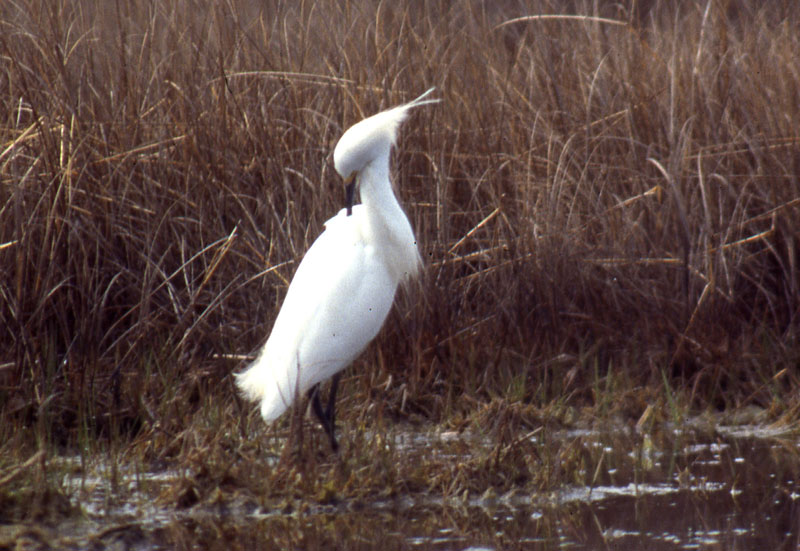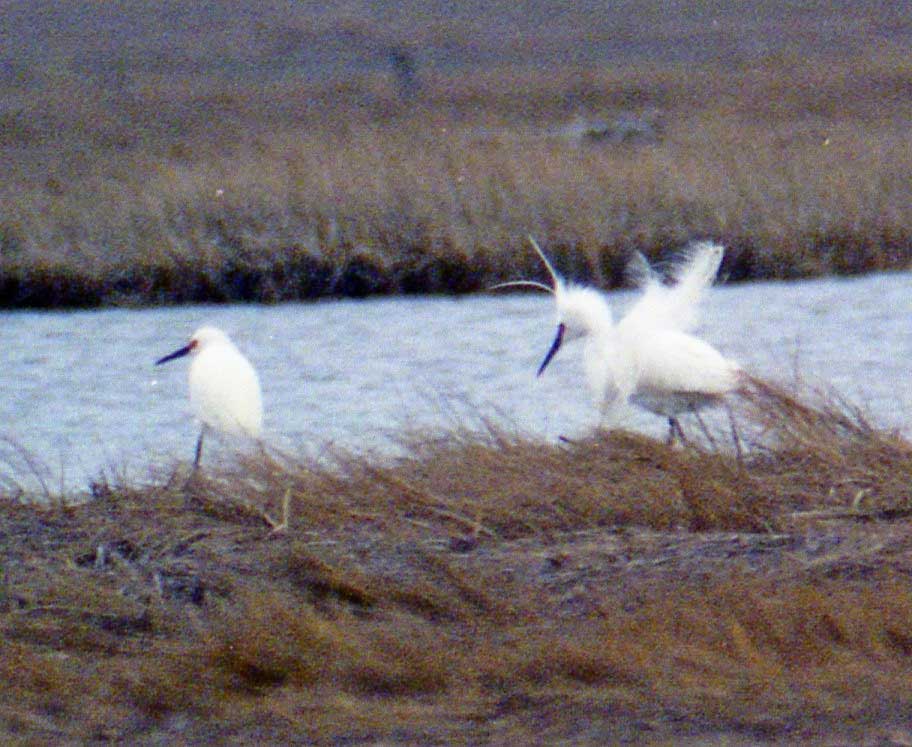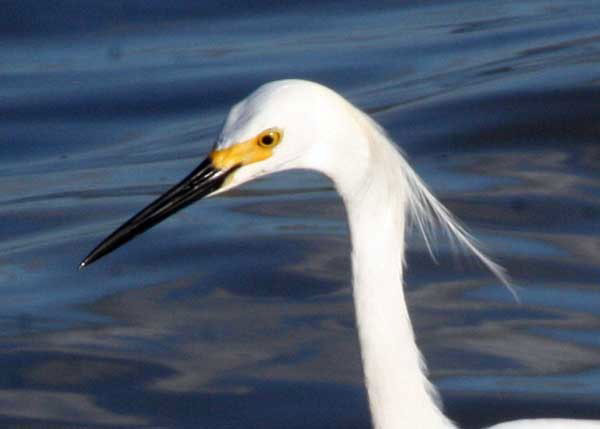
A few records of “Snowy” Egrets with long head plumes have turned up in places where Little Egret has also occurred. Are they hybrids, or just rare variants of Snowy?
Update 6 Aug 2011 – I had overlooked Martin Reid’s photos from Texas in May 1998 of a very similar long-plumed Snowy-like Egret. So obviously there is a record from Texas, where a Little Egret hybrid is far less likely to show up, and this seems to tilt the balance a little more towards pure Snowy Egret. In addition, Steve Mlodinov reports a long-plumed bird similar to the Antigua photos, from southern Baja California, Mexico. The plumes of the Connecticut and New Hampshire birds still look a little more sturdy than this, but it’s hard to say for sure, and it becomes harder to argue that those are hybrids if the others are not….
Little Egret (Egretta garzetta) and Snowy Egret (Egretta thula) are extremely similar species occupying large areas of the Old World and New World, respectively. Since the 1980s (with a major influx in the early 1990s) Little Egret has been detected in small and increasing numbers in the West Indies, with breeding records on Barbados, and a few individuals have also appeared along the Atlantic coast of the US and Canada. Given their similarity in appearance and behavior, and the fact that some Little Egrets in eastern North America have stayed through the summer, associating with Snowy Egrets, hybridization is plausible. Copulation was observed in a mixed pair at Barbados in 1999 (fide Floyd Hayes, ID-Frontiers email 22 Apr 2008), but whether any hybrid offspring fledged is unknown.
For more details on the plumes of these two species see my post on Differences in plumes of Little and Snowy Egret.
The two species are so similar that detecting and identifying a hybrid is extremely difficult. The Connecticut, New Hampshire, and Antigua birds discussed here, a record from Florida, and one sight record from Trinidad are the only reports of possible hybrids ever published. It is possible that the Connecticut and three New Hampshire records could involve repeat sightings of one individual, but there is no way to know.
Records
10 May 1995, Hammonasset Beach State Park, CT, photo above and more below
28-29 Apr 1990, Hampton, NH, photos below
20 Apr 1997, Rye, NH ((fide Steve Mirick))
1998, Newmarket, NH ((fide Steve Mirick))
Apr 1993, Pinellas Co. FL, ((The record from Florida involves a long-plumed egret identified as a Little. The Florida bird records committee did not accept it as such, saying that it could have been a Snowy with long plumes (brief discussion in pdf here http://www.fosbirds.org/sites/default/files/FFNs/FFNv24n4p123-134Anderson-FOSRC12.pdf photos apparently on file in Florida, I have not seen them).))
17-18 Apr 2008, Antigua, two or three birds, photo below (Jaramillo, 2008)
Trinidad ((sight record reported in McCarthy, 2006, no other details))
May 1998, Fort Worth, Texas photos here: http://www.martinreid.com/Main%20website/egrets2.html
Photos of the Connecticut bird (above, and more below) show what is essentially a Snowy Egret (with yellow lores, bushy crest), except for the two long lanceolate plumes that extend well beyond the normal Snowy Egret crest. Snowy Egrets often show a few slightly longer feathers in the midst of their lacy crest, and the lacy plumes can sometimes clump together to form more obvious strands, but the individual feathers are always extremely flimsy and lacy. The extreme length of these plumes, however, and the fact that they are bending in the wind without breaking up, seems so far beyond the normal range of variation in Snowy Egret that I think a hybrid is the more plausible explanation.

The 1990 New Hampshire bird (above, and more photos below) shows a similar bushy crest with two long lanceolate plumes. This bird has darker orange facial skin as in the high-breeding condition of Snowy and Little Egrets, which might indicate that it was nesting somewhere in the area. The very long plumes blown up by the wind are clearly not the typical fine lacy plumes of Snowy Egret.

Photos of one bird from Antigua (where at least two or three similar individuals were thought to be present) show a Snowy-like Egret with lacy crest and several much longer, but still lacy, feathers. The Texas bird also seems to show long but somewhat lacy plumes. Photos of these birds show long plumes, but with a more Snowy-like feather structure than the Connecticut and New Hampshire birds show. It is impossible to determine the actual feather structure of the latter birds, but the plumes look thicker and more sturdy, more like Little Egret.
Pros and Cons
The main argument against these being hybrids is that they do not show any sign of Little Egret influence other than the long head plumes. BUT, the two species are so similar in all respects, there is no reason to expect a hybrid to stand out in any way other than head plumes. Some Little Egrets are larger than Snowy Egrets, but overall size and bill size overlaps extensively. The back plumes are slightly less curled on Little. The breast plumes are slightly thicker on Little. The facial skin is often gray on Little, but turns yellow to red in breeding season. It is plausible that a hybrid would show yellow loral skin all year and no detectable difference in size, back plumes, or breast plumes.
One point in favor of the hybrid theory is that they have only been found in places where Little Egret is known to occur with Snowy. BUT, maybe that’s simply because in those places people are looking very hard for Little Egret and notice the long head plumes. These birds would be easily overlooked in other places where Little Egret is not actively searched for. If birders looked this hard for Little Egret in Texas, for example, would they find long-plumed Snowys there as well? Some people do look for Little Egret in Texas, and have never reported plumes like this. Alvaro Jaramillo, after seeing possible hybrids on Antigua, has looked very closely at Snowy Egrets in California and elsewhere and has not seen any with plumes like the Antigua birds. Many birders have watched for Little Egret in Florida, and only one “long-plumed Snowy” has been found there.
Conclusion
My guess is that the Connecticut and New Hampshire birds are hybrids. The structure of the plumes seems to show the broad, lanceolate shape typical of Little Egret. The Antigua bird certainly shows long plumes, and may be a hybrid, but the structure of the plumes looks similar to typical Snowy Egret, and this may represent the extreme of length in Snowy Egret plumes.
This question might never be fully resolved unless one of these odd birds can be captured (or a feather retrieved) for DNA testing. If observers in other parts of the range of Snowy Egret can document that similar individuals do occur in California, Texas, etc, that would suggest that the plumes are a rare variant of Snowy and not a hybrid feature.
Photo Gallery
[portfolio_slideshow]
References
Wilson, A. 1999. Separation of Little Egret (Egretta garzetta) from Snowy Egret (E. thula). http://www.oceanwanderers.com/LTEGRT.html – discussion and photos of a Little Egret in Delaware.
Hayes, F. IDENTIFICATION ESSAY: Little Egret (Egretta garzetta) and Snowy Egret (E. thula). http://secrb.trinidadbirding.com/idlittlesnowyegret.html – detailed notes and many photos from Trinidad.
Anonymous. Snowy Egret Egretta thula or Little Egret Egretta garzetta? http://azores.seawatching.net/index.php?page=egret Discussion of the identification of vagrants on the Azores
Jaramillo, A. 2008. CARIBBEAN EGRETS: LITTLE EGRETS. http://www.coastside.net/chucao/gulls/egrets.htm – photos showing variation of Little Egret in the Lesser Antilles, and one possible hybrid x Snowy Egret very similar to the Connecticut bird.
Reid. M. http://www.martinreid.com/Main%20website/egrets.html – Martin Reid’s web pages with lots of discussion of variation in Snowy Egret as it applies to Little Egret identification in Texas;
Massiah, E. (1996) Identification of Snowy Egret and Little Egret. Birding World 9(11): 434-444.
Grant, P. J. et al., (1980) Bare-part colour of Snowy and Little Egrets. British Birds 73: 39-40.
McLaren, I. A. (1989) Thoughts on North American Little Egrets. Birding 21: 284-287.
Sibley, D. (1997) Snowy vs Little Egret. ID-Frontiers: 27 Aug 1997.
McCarthy, E. M. 2006. Handbook of avian hybrids of the world. Oxford Univ. Press. 583 pp.
Notes
Thanks to Mark Szantyr, Steve Mirick, Alvaro Jaramillo, and Louis Bevier for photos and help with this note.


Dear David,
I’d like to ask you to reconsider if in fact “The Texas bird also seems to show long but somewhat lacy plumes.” as you say above. The close-up of the SINGLE long plume on the Texas bird seems lanceolate to me – in fact I feel it is perhaps a better candidate for being entirely lanceolate than the plume/plumes visible on the pics of the CT bird above, which seem a bit degraded at the tip and along the side (esp in 4th pic above)… Anyway FYI I can tell you from seeing the Texas bird that the lone long plume was lanceolate and similar to those of many Little Egrets I’ve seen in Europe and Asia – albeit a bit shorter. I plan to check my photos (if I can find them) of the Texas bird to see if the lower neck plumes show evidence of lanceolate feathers!
All the best,
Martin
Egrets, except in optimal breeding plumage, are not as easy has the guides suggest.
With very detailed observation over years there is much variation in plumage and leg colour to be discovered. Little versus Chinese Egret has made interesting study, for some.
I doubt the birds here are Little, Little has been shown to have Snowy type leg colour in Asia and elsewhere. Just the vivid chrome yellow of the lores and the beak shape and tonality do preclude, Little for me. I do not know Snowy in detail but are the plumes really so lonf\g as to preclude natural length or hormonal growth of some sort.
Some marginal photos of a presumed hybrid Little x Snowy Egret at Bombay Hook NWR in April 2007 are included here. It was seen by many, and last I heard it was thought to be more than just an aberrant snowy. Far better photos exist of this bird.
http://www.flickr.com/photos/71649753@N07/8410598833/in/set-72157632576687597
http://www.flickr.com/photos/71649753@N07/8410598697/in/set-72157632576687597/
Jay Keller, San Diego, CA
Hi Jay, Thanks for the link. That bird certainly looks consistent with the others… adding to the mystery.
An interesting Egret found and photographed yesterday in Colorado. The majority with experience with both species believe it is an aberrant Snowy based on structure (rounder head, relatively small bill, fairly refined legs, slight upturn to back feathers, same size as Snowy). As every photo shows, the two filoplumes are very long and well defined and definitely not lacy, and the bird really is not shaggy on the head at all like a Snowy. I have never seen a Little so can not personally make any assessment of how this bird fits into the spectrum, however if it is indeed “just a Snowy” more support for plume variation rather than hybrids for the birds posted above. Short of DNA not sure how one could conclusively say.
https://www.flickr.com/photos/aphelionart/sets/72157645245956205/o
Sorry that link is bad… Here is the correct link: https://www.flickr.com/photos/aphelionart/sets/72157645245956205/. (Or just edit and erase the o on the end of the above link)
FYI another similar bird from New Jersey in April 2015:https://www.flickr.com/photos/shearh2o/sets/72157649834748283/
Thanks for the link Martin, great photos of another interesting bird.
Dear David,
Yesterday, 13 April 2021, I found this apparent candidate for Little x Snowy Egret hybrid. The two lanceolate plumes are extremely long and are rather thick plumes, not like the fine breeding plumes of Snowy Egret. Here is a link to my eBird checklist: https://ebird.org/checklist/S85456787.
Best wishes,
Michael Brothers
I have seen a bird similar to the photo by Alvaro but in Barbados – see third bird from the right in the image included in this ebird checklist: https://ebird.org/checklist/S83315722 . Unfortunately the bird was some distance away and therefore not a good photo.
Here is another possible hybrid to add to the mix. April 2022 on Cape Cod, Mass. https://ebird.org/vt/checklist/S107796597
Both a shaggy crest and two long plumes. Thoughts welcome!
Kyle Jones